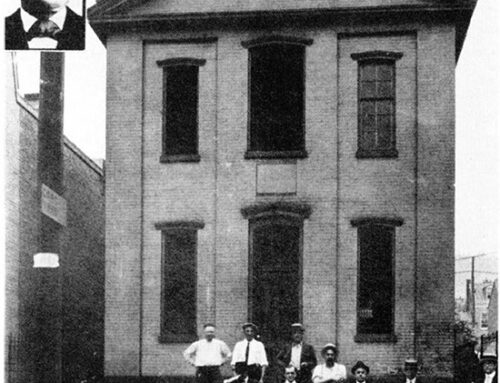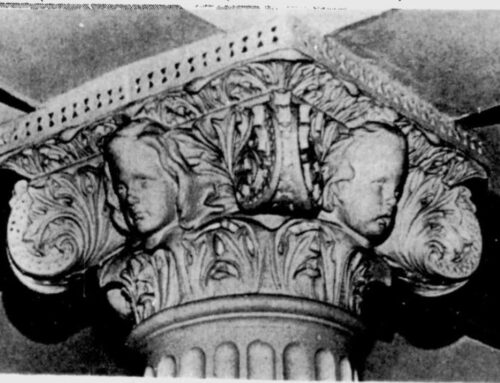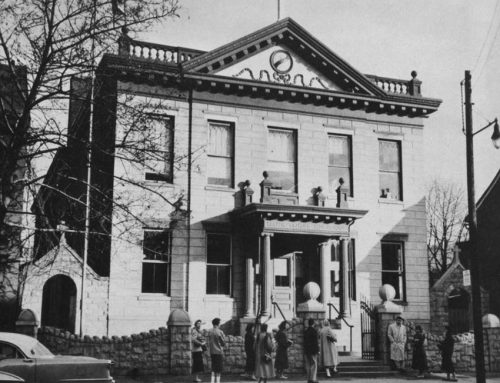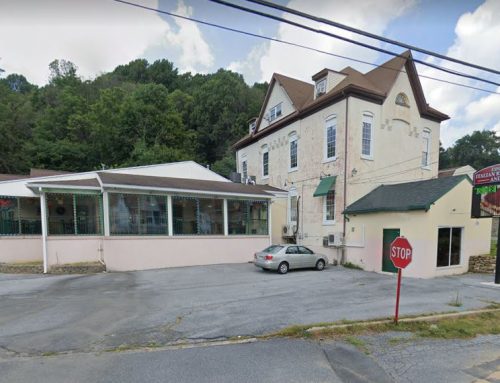The Fifth and Spring school house was an 8-room building erected in 1900. The school was adjacent to Church and Spring school, a 4-room building erected in 1894.
Below: Fifth and Spring school located on the northeast corner of Fifth and Spring Streets, and Church and Spring School located on the northwest corner of Spring and Church.

Reading indulged in the somewhat strange practice of sometimes erecting two separate schoolhouses on the same property – each with its own principal. This could cause problems at times – largely due to sharing a common playground. Accordingly, recess times usually were staggered because of limited play area – and in warm weather, when windows were fully opened, you had the other building’s noise to contend with. It’s on record that on several occasions, the principal from Building #1 marched over to the principal of Building #2 to complain…and vice versa. As might be expected, on occasion, this resulted in a feud.
Throughout America, neighborhood schools were the backbone of a rudimentary public education. In the era before busing, children not only walked to and from school, most also walked home (and back) for lunch. Accordingly, and especially for primary-level pupils, schools had to be a neighborhood accommodation. During that era, Reading had 45 elementary schools scattered throughout the city, many only 2 or 3 blocks apart.
In 1923, a report was issued by the Commonwealth of Pennsylvania’s Bureau of School Buildings (Department of Public Instruction) that rated the 48 structures then being used in the city for educational purposes. The report graded the buildings based on sanitary conditions, lighting, general construction, location, playground space, ventilation, service systems, classroom utility, etc.
Reading was but one of many districts throughout the state that underwent scrutiny. The report concluded that more than half the Reading school buildings were strongly recommended for abandonment. The worst was the 1891 Poplar Street structure.
To drive the point home, pictures were prepared that showed coats hanging all around the hallways (Rose and Washington), dungeon-like lavatory facilities located in rudimentary basements (Church and Oley and Church and Spring), narrow wooden stairways with high risers (old Riverside and Ricktown/ Schuylkill Avenue and West Elm), outside toilets (old Glenside), and grossly inadequate playground space.
Some low-scoring structures were preserved by major renovation – Schuylkill Avenue and Ritter and Spring and Church, among others. The Elm and Madison Avenue building was salvaged by razing the older building on the same lot, thus providing additional play space. Lavatory facilities were upgraded throughout the district.
The survey of 1923 recommended that Church and Spring be replaced. As there was a decided need for more classrooms in this area and the building was structurally sound, the School Board decided to refurbish it and attach same to Fifth and Spring. In so doing, four additional classrooms would be gained, plus rooms for allied use. The joining, based on design work by Miles B. Dechant, took place in 1925 and 1926. When completed on Sept. 21, 1926, the new Fifth and Spring had a modern look – and a flat roof. When closed in 1979, most pupils and teachers were transferred to the enlarged Riverside building. William Hertzog was the last principal here. Fifth and Spring was razed during July and August 1982. A convenience store now occupies the site.
Below: Fifth and Spring, as it appeared shortly before demolition. In actuality, it only looked like this after a conjoining of two Victorian buildings in 1925 and part of 1920. The first schoolhouse on the block, erected in 1894, sat on the northwest corner of Spring and Church. As it had only 4 rooms, there soon was a need for more class space so, in 1900, the original Fifth and Spring schoolhouse was erected; see left INSET. The Spring and Church building appears in the right INSET, which seems to abut Fifth and Spring, but it did not; there was a walkway between the two. Center INSET is the Turkey Hill convenience store that now occupies the former school-site.

Below: Fifth and Spring, as it appeared shortly before demolition.
![]()
![]()






Leave A Comment